FÓSILES EN LA ACRÓPOLIS (ESP)
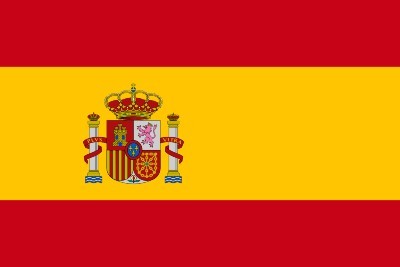
Subiendo al Partenón, si tu miras al muro del templo de la diosa Nike tú puedes ver fósiles. Esta será la temática del earthcache, los fósiles.
¿QUÉ SON LOS FÓSILES?
Los fósiles son los restos o señales de la actividad de organismos pretéritos. Dichos restos, conservados en las rocas sedimentarias, pueden haber sufrido transformaciones en su composición o deformaciones más o menos intensas. La ciencia que se ocupa del estudio de los fósiles es la paleontología.
TIPOS DE FÓSILES
ESTROMATOLITOS

Los fósiles más antiguos son los estromatolitos, que consisten en rocas formadas por la precipitación y fijación de carbonato cálcico, merced a la actividad bacteriana. Esto último se ha podido saber gracias al estudio de los estromatolitos actuales, producidos por tapetes microbianos. La formación Gunflint contiene abundantes microfósiles ampliamente aceptados como restos microbianos.
Hay muchas clases de fósiles. Los más comunes son restos de ammonoidea, caracoles o huesos transformados en piedra. Muchos de ellos muestran todos los detalles originales del caracol o del hueso, incluso examinados al microscopio. Los poros y otros espacios pequeños en su estructura se llenan de minerales.
Los minerales son compuestos químicos, como la calcita (carbonato de calcio), que estaban disueltos en el agua. El paso por la arena o el lodo que contenían los caracoles o los huesos y los minerales se depositaron en los espacios de su estructura. Por eso los fósiles son tan pesados. Otros fósiles pueden haber perdido todas las marcas de su estructura original. Por ejemplo, una concha de caracol originalmente de calcita puede disolverse totalmente después de quedar enterrada. La impresión que queda en la roca puede llenarse con otro material y formar una réplica exacta de la concha. En otros casos, la concha se disuelve y tan solo queda el hueco en la piedra, una especie de molde que los paleontólogos pueden llenar con yeso para descubrir la forma del resto.
Desde un punto de vista práctico distinguimos:
Microfósiles (visibles al microscopio óptico).
Nanofósiles(visibles al microscopio electrónico)
Macrofósiles o megafósiles (aquellos que vemos a simple vista).
Los fósiles por lo general solo muestran las partes duras del animal o planta: el tronco de un árbol, el caparazón de un caracol o los huesos de un dinosaurio o un pez. Algunos fósiles son más completos: registran una mayor cantidad de información paleobiológica. Si una planta o animal queda enterrado en un tipo especial de lodo que no contenga oxígeno, algunas de las partes blandas también pueden llegar a conservarse como fósiles.
Los más espectaculares de estos "fósiles perfectos" son mamuts lanudos completos hallados en suelos congelados. La carne estaba tan congelada, que aún se podía comer después de 20 000 años. Los fósiles más recientes, por convenio, son los referidos a organismos que vivieron a finales de la última glaciación cuaternaria, es decir, hace unos 13 000 años aproximadamente. Los restos posteriores (Neolítico, Edad de los Metales, etc.) suelen considerarse ordinariamente como subfósiles.
Finalmente deben considerarse también aquellas sustancias químicas incluidas en los sedimentos que denotan la existencia de determinados organismos que las poseían o las producían en exclusiva. Suponen el límite extremo de la noción de fósil (marcadores biológicos o fósiles químicos).
ICNOFÓSILES
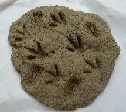
Los icnofósiles son restos de deposiciones, huellas, huevos, nidos, bioerosión o cualquier otro tipo de impresión. Son el objeto de estudio de la Paleoicnología.
Los icnofósiles presentan características propias que les hacen identificables y permiten su clasificación como parataxones: icnogéneros e icnoespecies. Los parataxones son clases de pistas fósiles agrupadas por sus propiedades comunes: geometría, estructura, tamaño, tipo de sustrato y funcionalidad. Aunque a veces diagnosticar la especie productora de un icnofósil puede resultar ambiguo, en general es posible inferir al menos el grupo biológico o el taxón superior al que pertenecía.
En los icnofósiles se pueden identificar varios tipos de comportamiento: filotaxia, fobotaxia, helicotaxia, homostrofia, reotaxia y tigmotaxia.
El término icnofacies hace referencia a la asociación característica de pistas fósiles, recurrente en el espacio y en el tiempo, que refleja directamente condiciones ambientales tales como la batimetría, la salinidad y el tipo de sustrato. Las pistas y huellas de invertebrados marinos son excelentes indicadores paleoecológicos, al ser el resultado de la actividad de determinados organismos, relacionada con ambientes específicos, caracterizados por la naturaleza del sustrato y condiciones del medio acuático, salinidad, temperatura y batimetría. Especialmente la profundidad del mar condiciona el género de vida de los organismos y, por tanto, no es de extrañar que se puedan distinguir toda una serie de icnofacies de acuerdo con la batimetría, cuya nomenclatura, debida a Seilacher,9 se refiere al tipo de pistas más frecuentes y más carcterísticas de cada una.
Un icnofósil puede tener varias interpretaciones:
Filogenética: Estudia la identidad del organismo productor. Da lugar a los parataxones.
Etológica: Estudia el comportamiento del organismo productor.
Tafonómica: Se interesa por la posición original y los procesos tafonómicos sufridos.
Sedimentológica: Revela las condiciones paleoambientales de formación.
Paleoecológica: Estudiada por las icnofacies.
MICROFÓSILES
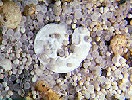
"Microfósil" es un término descriptivo que se aplica al hablar de aquellos fósiles de plantas o animales cuyo tamaño es menor de aquel que puede llegar a ser analizado por el ojo humano. Normalmente se utilizan dos rasgos diagnósticos para diferenciar microfósiles de eucariotas y procariotas:
Tamaño: Los eucariotas son sensiblemente mayores en tamaño a los procariotas, al menos en su mayoría. Complejidad de las formas: Las formas más complejas se asocian con eucariotas, debido la posesión de citoesqueleto.
RESINA FÓSIL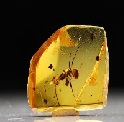
La resina fósil (también llamada ámbar) es un polímero natural encontrado en muchos tipos de estratos por todo el mundo, incluso en el Ártico. Se trata de la resina fosilizada de árboles hace millones de años. Se presenta en forma de piedras amarillentas.
La resina en su momento pudo atrapar insectos y pequeños animales debilitados, los que aparecen dentro del ámbar.
PSEUDOFÓSIL
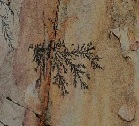
Los pseudofósiles son patrones visuales en rocas, producidos por procesos geológicos, que se asemejan a formas propias de los seres vivos o sus fósiles; un ejemplo clásico son las dendritas de pirolusita (óxido de manganeso, MnO2), que parecen restos vegetales. La interpretación errónea de los pseudofósiles ha generado ciertas controversias a lo largo de la historia de la Paleontología. En el año 2003, un grupo de geólogos españoles puso en entredicho el origen orgánico de los fósiles de Warrawoona que, según William Schopf, correspondían a cianobacterias que constituían el primer rasgo de vida sobre la Tierra hace 3.500 millones de años. La base de tal replanteamiento era que estructuras filamentosas, similares a estos supuestos microfósiles de Warrawoona, pueden ser producidos a temperatura y presión ambiente por la combinación, en un medio alcalino, de una sal de bario y un silicato. Un nuevo estudio publicado en 2015 por la revista PNAS resolvió finalmente la controversia. Los investigadores David Wacey y Martin Saunders utilizaron microscopía electrónica de transmisión para examinar rebanadas ultradelgadas de los candidatos a microfósiles y así construir mapas a escala nanométrica de su tamaño, forma, química y distribución de carbón mineral. Esto hizo evidente que la distribución de carbono era diferente a todo lo visto en microfósiles auténticos y revelando su origen mineral.
FÓSIL VIVIENTE
Un fósil viviente es un término informal usado para referirnos a cualquier especie viviente que guarde un gran parecido con una especie conocida por fósiles (se podría decir que es como si el fósil hubiera "cobrado vida").
Los braquiópodos son un ejemplo perfecto de "fósiles vivientes". Lingula es un braquiópodo actual del que se encuentran fósiles a través de todo el Cenozoico. Otro ejemplo es el celacanto. Fue una gran sorpresa encontrar este pez en las costas de África en 1938, cuando se pensaba que llevaban 70 millones de años extintos.
PROCESOS DE FOSILIZACIÓN
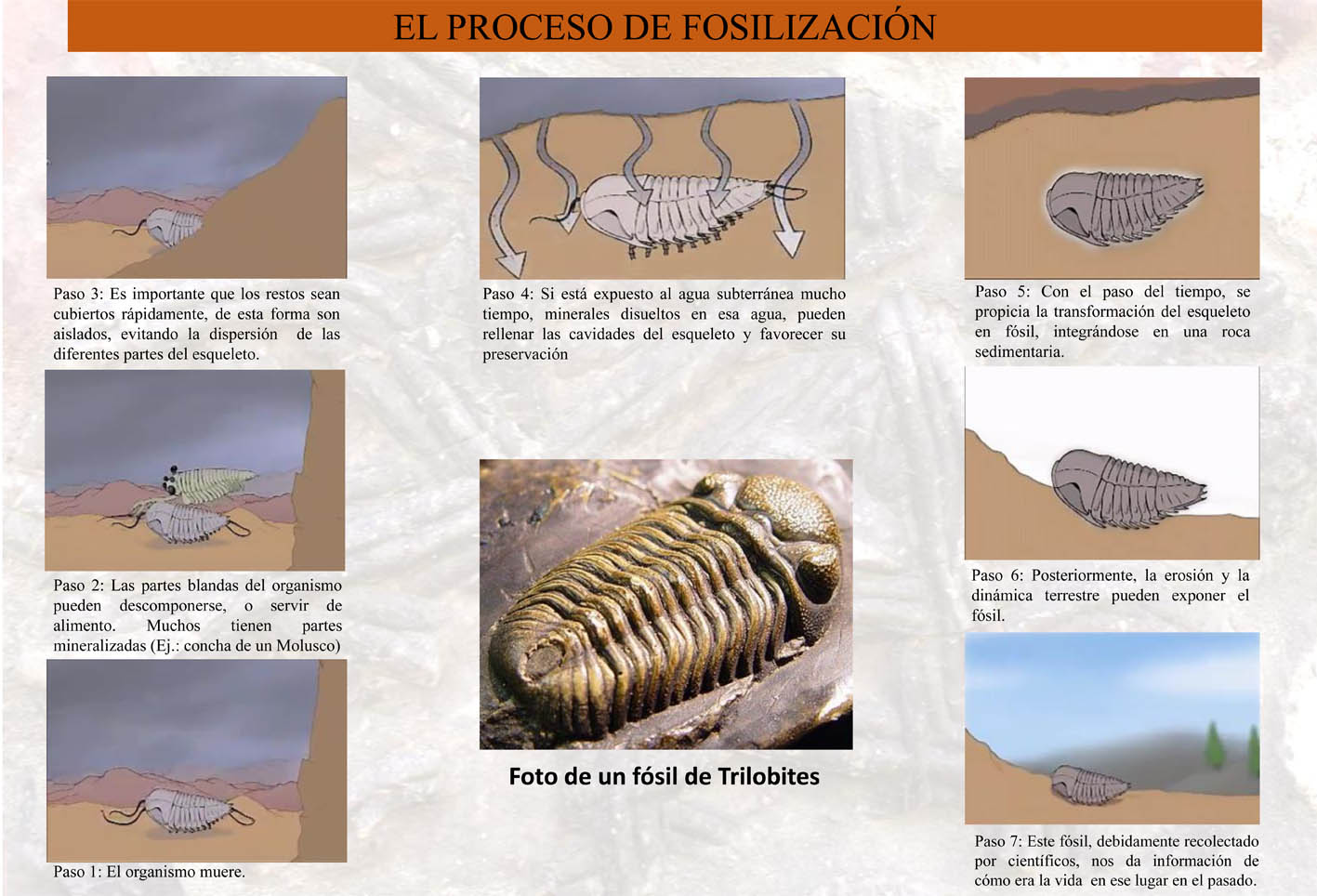
Cuando un organismo muere, sus restos se descomponen y disgregan rápidamente por la acción de las bacterias, otros animales, el viento, la lluvia, o las olas del mar. Pero si ese cadaver es enterrado en poco tiempo por los sedimentos, y se ve a salvo de la intervención de los agentes biológicos y mecánicos crecen mucho las posiblidades de que fosilice. Obviamente es mucho más sencillo que lo hagan las partes duras como conchas y huesos, que las partes blandas como los músculos y vísceras que a pesar de su enterramiento siguen expuestos a la acción de las bacterias. Todo depende de lo hermético que sea el envoltorio protector que rodea al organismo. En casos excepcionales también se conservan esas partes blandas, y se han encontrado insectos esquisitamente preservados en ámbar, que es resina fósil de árboles, vertebrados en minas de asfalto, o mamuts congelados en la turba de Siberia.
Salvo esas raras excepciones, el proceso de fosilización comienza a partir de la desaparición de las partes blandas y el relleno de los huecos por el sedimento circundante. En ese momento empiezan a producirse una serie de transformaciones químicas que poco a poco van sustituyendo los compuestos orgánicos de esos restos por minerales.
Esta transformación depende de la composición química del hueso o concha, y de la del sedimento que lo contiene, si esta combinación es favorable, la sustitución se realizará molécula a molécula, durante un largo, muy largo período de tiempo, hasta que el organismo esté completamente mineralizado, es decir, convertido en piedra.
Si por causa de la erosión, o por la acción del hombre la roca que lo contiene queda expuesta en la superficie, estará sometida a los procesos erosivos a los que se ve sometido el relieve, y se destruirá en un tiempo más o menos corto. Ahora, si es recogido racionalmente, teniendo en consideración que no es solo una bonita piedra para poner encima del televisor, sino que es una fuente de información sobre la vida pasada, tendremos una joya de la naturaleza llamada fósil.
PROCESOS QUÍMICOS DE FOSILIZACIÓN
Cuando los organismos quedan enterrados en el sedimento, lo primero que sucede es la destrucción de la materia orgánica blanda. Si esta es de origen animal se forma una masa rica en nutrientes que es consumida por las bacterias, y que ocasionalmente puede dar lugar a la formación de petroleo. Y si es de origen vegetal forma humus, que bajo ciertas circunstancias puede llegar a convertirse en carbón.
Las partes duras como los huesos y conchas sufren un proceso de mineralización por intercambio y aporte de sustancias químicas con el sedimento que los contiene, estos procesos pueden ser muy variados, pero los principales son: Carbonatación, Silicificación, Piritización, Fosfatación y Carbonificación.
CARBONATACIÓN
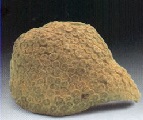
Es el proceso de fosilización más frecuente, consiste en la sustitución de los restos orgánicos duros por carbonato cálcico en forma de calcita, si tenemos en cuenta que la calcita es el mineral más frecuente en las rocas sedimentarias, y que las conchas y caparazones de muchos invertebrados está formado por calcita, da como resultado que sea el proceso habitual de creación de muchos fósiles. Los corales tienen su esqueleto formado por calcita, lo que hace posible una rápida fosilización y la conservación extraordinaria de sus detalles. También muchos moluscos tienen su concha formada por carbonato cálcico en forma de aragonito, este se transforma en calcita que es la estructura más estable para el carbonato cálcico.
SILICIFICACIÓN
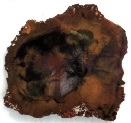
En determinadas situaciones el sílice da lugar a soluciones químicas que actuan como agente fosilizante, su forma más habitual y estable es la calcedonia. Se pueden encontrar fósiles silíceos incluso en rocas calizas, siendo frecuente en foraminíferos, equínidos, ammonites, braquiópodos y gasterópodos, hay que destacar también los hermosos jaspes xiloides procedentes de la fosilización de troncos y ramas de árboles.
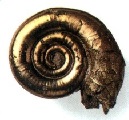 PIRITIZACIÓN
PIRITIZACIÓN
Cuando la materia orgánica se descompone en un ambiente carente de oxígeno se produce ácido sulfhídrico, que reacciona con las sales de hierro del agua marina produciendo sulfuros de hierro, generalmente marcasita y pirita, que sustituyen a la materia de origen orgánico de las conchas y esqueletos.
Si la pirita se conserva inalterada los fósiles presentan un aspecto metálico, pero esto no sucede habitualmente sobre todo con los fosilizados en marcasita, suelen aparecer limonitizados, y se oxidan y destruyen rápidamente en contacto con la atmósfera.
FOSFATACIÓN
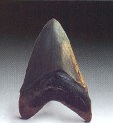
Es una de las formas frecuentes de fosilizar los restos de vertebrados, sobre todo cuando se produce gran acumulación de ellos.
El fosfato cálcico que es el principal componente de los huesos y dientes, hace de agente fosilizante, viéndose reforzado por el aporte de carbonato cálcico del sedimento que rellena los poros internos de los huesos. Las minas de fosfatos explotadas comercialmente son auténticas graveras de fósiles, formadas por infinidad de huesos y dientes.
CARBONIFICACIÓN
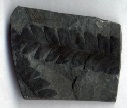
Es la forma más habitual de fosilización de los restos vegetales formados por celulosa , y de los artrópodos que su esqueleto está formado por quitina. La acumulación de troncos y hojas en un ambiente con ausencia de oxígeno en primer lugar produce humus, si el proceso continúa, aumentando la presión, y con una progresiva sustitución del resto de los componentes orgánicos por carbono, acaba formándose carbón.
Durante el período carbonífero la Tierra estaba poblada por densos bosques que propiciaron que este proceso se produjera durante 60 millones de años, dando nombre a este período, de él proceden la mayor parte de las minas de carbón.
Son muchos más los posibles procesos de fosilización, alguno ya los mencioné antes, como la conservación en ámbar y en bolsas asfálticas, otros se producen por la acción geoquímica de otros muchos minerales no mencionados que actúan como agentes fosilizantes. Aquí he expuesto los más habituales que es posible identificar en la mayor parte de los fósiles.
Para poder registrar este earthcaché deberás enviarnos las respuestas a las siguientes preguntas al e-mail , todos aquellos registos que no envíen las respuestas, serán borrados.
- Dime con tus palabras qué es un fósil
- Dime con tus palabras cual es el proceso de fosilización
- ¿Qué proceso químico de la fosilización son los fósiles de las coordenadas?
- ¿Hay un fósil o un pseudofósil en las coordenadas?
- ¿Qué tipo de fósil o pseudofósil vés?
- ¿Cuáles son sus medidas?
- ¿Ves más fósiles del mismo tipo?
Si me respondiste a todas las preguntas, puedes registrar.
FOSSILS IN THE ACROPOLIS (ENG)

Going up to the Parthenon, if you look at the wall of the Temple of Athena Nike you can see fossils. This will be the theme of earthcache, fossils.
WHAT ARE THE FOSSIL?
Fossils are the remains or signs of the activity of past organisms. These remains, preserved in sedimentary rocks may have undergone changes in its composition more or less intense deformation. The science that deals with the study of fossils is Paleontology.
TYPES OF FOSSIL
STROMATOLITES

The oldest fossils are the stromatolites, consisting of rocks formed by precipitation and fixation of calcium carbonate, thanks to bacterial activity. The latter has been told by studying stromatolites current produced by microbial mats. The Gunflint formation contains widely accepted as microbial remains abundant microfossils.
There are many kinds of fossils. The most common are remains of Ammonoidea, shells or bones turned to stone. Many of them show all the original details snail bone or even examined microscopically. Pores and other small spaces in their structure are filled with minerals.
Minerals are chemical compounds, such as calcite (calcium carbonate), which were dissolved in water. Going through the sand or mud snails or containing bones and minerals are deposited in the spaces of their structure. Why fossils are so heavy. Other fossils may have lost all the marks of its original structure. For example, a snail shell originally calcite can be completely dissolved after being buried. The impression left in the rock can be filled with other material and form an exact replica of the shell. In other cases, the shell dissolves and it is the only hole in the stone, a kind of mold that paleontologists can fill with plaster to discover how the rest.
From a practical point of view we distinguish:
Microfossils (visible by light microscopy).
Nannofossils (visible by electron microscopy)
Macrofossil or megafossils (those we see with the naked eye).
Fossils usually show only the hard parts of the animal or plant: the trunk of a tree, the shell of a snail or the bones of a dinosaur or a fish. Some fossils are more complete: record a greater amount of paleobiological information. If a plant or animal is buried in a special type of sludge that does not contain oxygen, some of the soft tissue can also become preserved as fossils.
The most spectacular of these "perfect fossils" are complete woolly mammoths found in frozen soils. The meat was so frozen that you could still eat after 20,000 years. The most recent fossils, by convention, are those related to organisms that lived at the end of the last quaternary glaciation, ie, approximately 13 000 years ago. Subsequent remains (Neolithic, Metal Age, etc.) are usually regarded as subfossil.
Finally they should also be considered those chemicals included in the sediments that indicate the existence of certain bodies that possessed or produced exclusively. Represent the extreme limit of the notion of fossil (fossil biological or chemical markers).
TRACE FOSSILS

trace fossils are remains of depositions, footprints, eggs, nests, bioerosion or any other impression. Are the subject matter of the Paleoichnology.
trace fossils have characteristics that make them identifiable and allow their classification as parataxones: icnogéneros and icnoespecies. The parataxones kinds of fossil tracks are grouped by their common properties: geometry, structure, size, type of substrate and functionality. Although sometimes diagnose a ichnofossil producing species can be ambiguous, it is generally possible to infer at least biological or higher taxon group to which he belonged.
In the trace fossils can be identified several types of behavior. Filotaxia, fobotaxia, helicotaxia, homostrofia, reotaxia and tigmotaxia
The term ichnoassemblages refers to the characteristic association of fossil tracks, recurring in space and time, which directly reflects environmental conditions such as bathymetry, salinity and substrate type. The tracks and traces of marine invertebrates are excellent paleoecological indicators, as the result of the activity of certain bodies, related to specific environments, characterized by the nature of the substrate and conditions of waterways, salinity, temperature and bathymetry. Especially the sea depth determines the gender of living organisms and, therefore, no wonder that they can distinguish a series of ichnoassemblages according to the bathymetry, whose nomenclature, due to Seilacher, refers to the type of more frequent and more carcterísticas of each track.
A ichnofossil can have several interpretations:
Phylogenetic: Study the identity of the producer organism. It gives rise to parataxones.
Etológica: Study the behavior of the producing organism
. Taphonomic: Is interested in the original position and suffered
taphonomic processes. Sedimentological: Reveals the paleoenvironmental conditions
training. Paleoecological: Studied by the ichnoassemblages.
MICROFOSSILS

"Microfossils" is a descriptive term applied when speaking of those fossils of plants and animals whose size is less than that which can be analyzed by the human eye. Usually two diagnostic features used to differentiate eukaryotic and prokaryotic microfossils:
Size: Eukaryotes are substantially greater in size to prokaryotes, at least mostly. Complexity of forms: The most complex forms are associated with eukaryotes, because possession of cytoskeleton.
FOSSIL RESIN

The fossil resin is a natural polymer found in many types of strata throughout the world, including in the Arctic. This is fossilized tree resin millions of years ago. It comes in the form of yellowish stones.
The resin at the time could catch insects and small animals weakened, those appearing in the amber.
PSEUDOFÓSIL

Pseudofósiles are visual patterns in rocks, produced by geological processes that resemble living things themselves or their fossil forms; a classic example is the dendrites of pyrolusite (manganese oxide, MnO2), which appear plant debris. Misinterpretation of pseudofósiles has generated some controversy throughout the history of paleontology. In 2003, a group of Spanish geologists questioned the organic origin of fossils Warrawoona that, according to William Schopf, corresponded to cyanobacteria were the first feature of life on Earth 3,500 million years ago. The basis of this reformulation was to filamentary structures similar to these assumptions Warrawoona microfossils, can be produced at room temperature and pressure by combining, in an alkaline medium, a barium salt and a silicate. A new study published in the journal PNAS 2015 finally resolved the dispute. Researchers David Wacey and Martin Saunders used transmission electron microscopy to examine ultrathin slices of candidates for microfossils and build maps nanoscale size, shape, chemistry and distribution of coal. This became evident that the distribution of carbon was unlike anything seen in real microfossils and revealing its mineral origin.
LIVING FOSSIL
A living fossil is an informal term used to refer to any living species that keep a close resemblance to a species known from fossils (one might say it's as if the fossil had "come alive").
Brachiopods are a perfect example of "living fossils". Lingula is a current braquiópodo of fossil found throughout the Cenozoic. Another example is the coelacanth. It was a great surprise to find this fish off the coast of Africa in 1938, when it was thought that had been extinct 70 million years.
FOSSILIZATION PROCESSES

When an organism dies, its remains decompose and disintegrate rapidly by the action of bacteria, other animals, wind, rain, or the waves of the sea. But if that corpse is buried in a short time by sediments, and is safe from the intervention of biological and mechanical agents grow much the possibilities that fossilize. It is obviously much easier to do it the hard parts such as shells and bones, the soft tissue like muscles and viscera despite his interment still exposed to the action of bacteria. It all depends on how tight the protective wrapping it around the body. In exceptional cases these soft tissues are also preserved, and exquisitely insects found preserved in amber, which is fossilized resin of trees, asphalt mines vertebrates, or frozen mammoths in Siberia peat.
Except for those rare exceptions, the fossilization process starts from the disappearance of soft tissue and filling the gaps by the surrounding sediment. At that time a series of chemical transformations that are gradually replacing the organic compounds of the remains of minerals begin to occur.
This transformation depends on the chemical composition of bone or shell, and the sediment containing it, if this combination is favorable, replacement very long period of time molecule to molecule will be held for a long, until the body is completely mineralized, ie, turned to stone.
If because of erosion, or by the action of man the rock that contains it is exposed on the surface, shall be subject to erosion processes that is subjected relief, and will be destroyed in a fairly short time. Now, if collected rationally, taking into consideration that it is not just a pretty stone to put on the television, but a source of information about past life, we have a gem of nature called fossil.
CHEMICALS FOSSILIZATION PROCESSES
When the bodies are buried in the sediment, the first thing that happens is the destruction of the soft organic matter. If this is a rich animal mass nutrient is consumed by the bacteria, and can occasionally result in the formation of oil is formed. And if it is of plant origin form humus, which under certain circumstances can become coal.
The hard parts like bones and shells undergo a process of mineralization exchange and supply of chemicals with sediment that contains them, these processes can be varied, but the main ones are:. Carbonation, silicification, pyritization, Phosphating and coalification.
 CARBONATION
CARBONATION
Is the process most frequently fossilization, is the replacement of the organic remains hard calcium carbonate as calcite, if we consider that calcite is the most common in sedimentary rocks mineral, shells and shells of many invertebrates is formed by calcite, it results to be the usual process of creating many fossils. Corals have their skeleton formed by calcite, which makes possible a rapid fossilization and conservation extraordinary detail. Molluscs are also many shell formed by calcium carbonate in the form of aragonite, this becomes calcite is the most stable calcium carbonate structure.
 SILICIFICATION
SILICIFICATION
In certain situations the silica results in chemical solutions that act as agent fosilizante, its most common and stable form is chalcedony. They can be found even in fossil siliceous limestone, still prevalent in foraminifera, echinids, ammonites, brachiopods and gastropods must also highlight the beautiful xiloides Jaspers from fossilized tree trunks and branches.
 PYRITIZATION
PYRITIZATION
When organic matter decomposes in an environment lacking oxygen hydrogen sulfide, which reacts with iron salts from seawater producing iron sulfides generally marcasite and pyrite, which replace the subject of organic origin of the shells and skeletons occurs.
If pyrite remains unchanged fossil exhibit a metallic appearance, but this does not usually happen especially with fossilized in marcasite, limonitizados usually appear, and oxidize and destroy rapidly in contact with the atmosphere.
 PHOSPHATING
PHOSPHATING
It is one of the common forms of fossilized remains of vertebrates, especially when large accumulation of them occurs.
Calcium phosphate is the main component of bones and teeth, makes fosilizante agent, looking reinforced by the contribution of calcium carbonate sediment that fills the internal pores of the bones. Phosphate mines commercially exploited are authentic fossil gravel pits formed by countless bones and teeth.
COALIFICATION

It is the most common form of fossilized plant debris formed by cellulose, and arthropods skeleton consists chitin. The accumulation of trunks and leaves in an environment with absence of oxygen produces humus first, if the process continues, increasing the pressure, and a progressive replacement of other organic carbon components, just forming coal.
During the Carboniferous period the Earth was populated by dense forests that led this process occurred over 60 million years, giving name to this period, it comes most of the coal mines.
There are many other possible processes of fossilization, and some mentioned before, such as conservation amber and asphaltic bags, others are produced by geochemical action of many other minerals not listed fosilizantes acting as agents. Here I have outlined the most common it is possible to identify most of the fossils.
To register this EarthCache must send the answers to the following questions by e-mail, all those who do not send rows the answers, will be deleted.
1. Tell me with your words what a fossil is
2. Tell me with your words what the fossilization process is
3. What chemical process of fossilization are coordinate fossils?
4. Is there a fossil or pseudofossil in the coordinates?
5. What kind of fossil or pseudofossil do you see?
6. What are your measures?
7. Do you see more fossils of the same type?
Απολιθώματα στην Ακρόπολη

Πηγαίνοντας στο Πάνθεον, αν κοιτάξετε τον τοίχο του ναού της Αθηνάς Νίκης μπορείτε να δείτε απολιθώματα. Αυτό θα είναι το θέμα της γεωκρυφής, των απολιθωμάτων.
ΤΙ ΕΊΝΑΙ ΤΑ ΑΠΟΛΙΘΏΜΑΤΑ;
Τα απολιθώματα είναι τα υπολείμματα ή τα σημάδια της δραστηριότητας των οργανισμών ακινήτων. Αυτά τα υπολείμματα, διατηρημένα σε ιζηματογενή πετρώματα, μπορεί να έχουν υποστεί μετασχηματισμούς στη σύνθεσή τους ή περισσότερο ή λιγότερο έντονες παραμορφώσεις. Η επιστήμη που ασχολείται με τη μελέτη των απολιθωμάτων είναι η παλαιοντολογία.
Οι στρωματόλιθοι

Τα παλαιότερα απολιθώματα είναι στρωολιθίτες, τα οποία αποτελούνται από βράχους που σχηματίζονται από καθίζηση και στερέωση ανθρακικού ασβεστίου, χάρη στη βακτηριακή δραστηριότητα. Το τελευταίο έχει γίνει γνωστό χάρη στη μελέτη των τρεχόντων στρωολιθίδων, που παράγεται από μικροβιακά χαλάκια. Ο σχηματισμός Γκάνφλιντ περιέχει άφθονα μικροαπολιθώματα που γίνονται ευρέως αποδεκτά ως μικροβιακά υπολείμματα.
Υπάρχουν πολλά είδη απολιθωμάτων. Τα πιο κοινά είναι υπολείμματα αμμλοειδούς, σαλιγκάρια ή οστών που μετατρέπονται σε πέτρα. Πολλοί από αυτούς δείχνουν όλες τις αρχικές λεπτομέρειες του σαλιγκαριού ή του οστού, ακόμη και εξετάζονται κάτω από το μικροσκόπιο. Οι πόροι και άλλοι μικροί χώροι στη δομή τους είναι γεμάτοι με μέταλλα.
Τα ανόργανα άλατα είναι χημικές ενώσεις, όπως η καλτίδα (ανθρακικό ασβέστιο), που διαλύθηκαν στο νερό. Το πέρασμα μέσα από την άμμο ή τη λάσπη περιείχε τα σαλιγκάρια ή τα οστά και τα μέταλλα που εναποτίθενται στους χώρους της δομής τους. Γι ' αυτό τα απολιθώματα είναι τόσο βαριά. Άλλα απολιθώματα μπορεί να έχουν χάσει όλα τα σημάδια της αρχικής τους δομής. Για παράδειγμα, ένα κέλυφος σαλιγκαριού αρχικά του καλτσίου μπορεί να διαλυθεί εντελώς μετά την ταφή του. Η εντύπωση που απομένει στο βράχο μπορεί να γεμίσει με ένα άλλο υλικό και να σχηματίσει ένα ακριβές αντίγραφο του κελύφους. Σε άλλες περιπτώσεις, το κέλυφος διαλύεται και μόνο το χάσμα παραμένειστην έτρα, ένα είδος καλουπιού που οι παλαιοντολόγοι μπορούν να γεμίσουν με γύψο για να ανακαλύψουν το σχήμα των υπόλοιπων.
Από πρακτική άποψη διακρίνουμε:
Μικροαπολιθώματα (ορατά στο οπτικό μικροσκόπιο).
Νανοοστεόφυτα (ορατό στο ηλεκτρονικό μικροσκόπιο)
Μακροαπολιθώματα ή μεγαφοστεύλια (αυτά που βλέπουμε με γυμνό μάτι).
Τα απολιθώματα συνήθως δείχνουν μόνο τα σκληρά μέρη του ζώου ή του φυτού: τον κορμό ενός δέντρου, το κέλυφος ενός σαλιγκαριού, ή τα οστά ενός δεινόσαυρο ή ψαριού. Μερικά απολιθώματα είναι πιο ολοκληρωμένα: καταγράφουν μια μεγαλύτερη ποσότητα παλαιοβιολογικών πληροφοριών. Εάν ένα φυτό ή ζώο είναι θαμμένο σε ένα ειδικό είδος λάσπης που δεν περιέχει οξυγόνο, μερικά από τα μαλακά μέρη μπορούν επίσης να διατηρηθούν ως απολιθώματα.
Το πιο θεαματικό από αυτά τα "τέλεια απολιθώματα" είναι τα πλήρη λανμίδια μαμούθ που βρίσκονται σε κατεψυγμένα εδάφη. Το κρέας ήταν τόσο παγωμένο, που θα μπορούσε ακόμα να καταναλωθεί μετά από 20.000 χρόνια. Τα πιο πρόσφατα απολιθώματα, κατά σύμβαση, είναι αυτά που αναφέρονται σε οργανισμούς που ζούσαν στο τέλος του τελευταίου τεταρτοέρερων παγετώνων, δηλαδή περίπου 13.000 χρόνια πριν. Τα επακόλουθα υπολείμματα (Νεολιθική, εποχή μετάλλων, κτλ.) θεωρούνται συνήθως υποαπολιθώματα.
Τέλος, πρέπει επίσης να ληφθούν υπόψη οι χημικές ουσίες που περιλαμβάνονται στα ιζήματα, οι οποίες υποδηλώνουν την ύπαρξη ορισμένων οργανισμών που τους ανήκαν ή παρήγαγαν αποκλειστικά. Αντιπροσωπεύουν το ακραίο όριο της έννοιας των ορυκτών (βιολογικοί δείκτες ή χημικά απολιθώματα).
ΙΝΑΟΦΟΣΤΕΟΔΩΝ

Τα ιχθυοστεώματα είναι υπολείμματα από κινήσεις του εντέρου, πατημασιές, αυγά, φωλιές, βιοδιάβρωση ή οποιοδήποτε άλλο είδος εκτύπωσης. Αποτελούν αντικείμενο μελέτης της Παλαιονολογίας.
Τα ιχθυοστεόνια έχουν τα δικά τους χαρακτηριστικά που τους καθιστούν αναγνωρίσιμους και επιτρέπουν την ταξινόμησή τους ως παραβαίων: ιχθυγένη και ιχθυείδη. Οι παραφαώνες είναι κατηγορίες ορυκτών κομματιών που ομαδοποιούνται με τις κοινές ιδιότητές τους: γεωμετρία, δομή, μέγεθος, τύπος υποστρώματος και λειτουργικότητα. Αν και μερικές φορές η διάγνωση του παραγούμενου είδους ιχθυοστεοστίας μπορεί να είναι ασαφής, είναι γενικά δυνατόν να συναχθεί τουλάχιστον η βιολογική ομάδα ή η υψηλότερη ταξική κατηγορία στην οποία ανήκε.
Διάφοροι τύποι συμπεριφοράς μπορούν να ταυτοποιηθεί σε ιχθυάρια: φυλοταξιία, φωβοταξιία, ελικοκοκόμεια, ομοτροχία, αναταξία και τιμοταξιίδια.
Ο όρος ικαφότητες αναφέρεται στη χαρακτηριστική Ένωση ορυκτών κομματιών, επαναλαμβανόμενων στο χώρο και το χρόνο, οι οποίες αντικατοπτρίζουν άμεσα τις περιβαλλοντικές συνθήκες όπως η βαθυμετρία, η αλατότητα και ο τύπος υποστρώματος. Οι ράγες και τα ίχνη των θαλάσσιων ασπόνδυλων είναι εξαιρετικοί παλαιοί δείκτες, που είναι το αποτέλεσμα της δραστηριότητας ορισμένων οργανισμών, που σχετίζονται με συγκεκριμένο περιβάλλον, που χαρακτηρίζεται από τη φύση του υποστρώματος και τις περιβαλλοντικές συνθήκες αλατότητα, θερμοκρασία και βαθυμετρία. Ειδικά το βάθος της θάλασσας συνθήκες το φύλο της ζωής των οργανισμών και, ως εκ τούτου, δεν είναι έκπληξη ότι μια ολόκληρη σειρά από icnofaces μπορεί να διακριθούν σύμφωνα με τη βαθυμετρία, η ονοματολογία των οποίων, λόγω Seilacher, 9 αναφέρεται στον τύπο των κομματιών συν συχνή και πιο χαρακτηριστική του καθενός.
Ένα ιχθυοστεόψαρο μπορεί να έχει πολλές ερμηνείες:
Φυλογενετική: μελετά την ταυτότητα του οργανισμού παραγωγής. Δίνει αφορμή για παραφαόνες.
Αιθολογική: μελέτη της συμπεριφοράς του οργανισμού παραγωγής.
Τάττινιτς: ενδιαφέρεται για την αρχική θέση και τις δινομικές διεργασίες που υπέστησαν.
Καθίζση: αποκαλύπτει τις παλαιότερο περιβαλλοντικές συνθήκες σχηματισμού.
Παλαιοοικολογική: μελετήθηκε από τις ικαδότητες.
Μικροαπολιθωμάτων

"Μικροαπολιθωμένο" είναι ένας περιγραφικός όρος που ισχύει όταν μιλάμε για τα απολιθώματα φυτών ή ζώων των οποίων το μέγεθος είναι μικρότερο από αυτό που μπορεί να αναλυθεί από το ανθρώπινο μάτι. Δύο διαγνωστικά χαρακτηριστικά χρησιμοποιούνται συνήθως για τη διαφοροποίηση των μικροαπολιθωμάτων από ευκαρυωτές και προκαρυωτές:
Μέγεθος: οι Ευκαρυίτες είναι σημαντικά μεγαλύτεροι σε μέγεθος από τους προκαρυωτές, τουλάχιστον για το μεγαλύτερο μέρος τους. Πολυπλοκότητα των σχημάτων: πιο πολύπλοκες μορφές που συνδέονται με ευκαρυωτές, λόγω του κυτοσκελετού κατοχής.
 ΟΡΥΚΤΗ ΡΕΣΙΝΑ
ΟΡΥΚΤΗ ΡΕΣΙΝΑ
Απολιθωμένο ρητίνη (ονομάζεται επίσης κεχριμπάρι) είναι ένα φυσικό πολυμερές που βρίσκεται σε πολλά είδη στρωμάτων σε όλο τον κόσμο, συμπεριλαμβανομένης της Αρκτικής. Είναι η απολιθωμένη ρητίνη των δέντρων εκατομμύρια χρόνια πριν. Έρχεται με τη μορφή κιτρινωπών λίθων.
Η ρητίνη εκείνη την εποχή ήταν σε θέση να πιάσει έντομα και μικρά εξασθενημένα ζώα, τα οποία εμφανίζονται μέσα στο κεχριμπάρι.
ΨΕΥΔΟΑΠΟΛΙΘΩΜΑ

Τα ψευδοαπολιθώματα είναι οπτικά μοτίβα σε βράχους, που παράγονται από γεωλογικές διεργασίες που μοιάζουν με ζωντανά πράγματα ή τις ορυκτές μορφές τους. ένα κλασικό παράδειγμα είναι οι δενδρίτες του πυρολούδιου (οξείδιο του μαγγανίου, MnO2), που εμφανίζονται υπολείμματα φυτών. Η παρερμηνεία των ψευδοαπολιθωμάτων έχει προκαλέσει κάποια διαμάχη σε όλη την ιστορία της παλαιοντολογίας. Το 2003, μια ομάδα ισπανών γεωλόγων αμφισβήτησε τη βιολογική καταγωγή των απολιθωμάτων Γουουουολόγια που, σύμφωνα με τον Γουίλιαμ λόμφ, αντιστοιχούσε σε κυανοβακτηρίδια ήταν το πρώτο χαρακτηριστικό της ζωής στη γη 3.500.000.000 χρόνια πριν. Η βάση αυτού του ανασκευάσματος ήταν παρόμοια με αυτές τις παραδοχές τα μικροαπολιθώματα του Γουαγουόνα, μπορούν να παραχθούν σε θερμοκρασία δωματίου και σε συνδυασμό με πίεση, σε αλκαλικό μέσο, αλάτι βαρίου και πυριτικό άλας. Μια νέα μελέτη που δημοσιεύθηκε στο ημερολόγιο PNAS 2015 τελικά έλυσε τη διαφωνία. Οι ερευνητές David Wacey και Martin Σόντερς χρησιμοποίησαν ηλεκτρονική μικροσκοπία για να εξετάσουν εξαιρετικά λεπτές φέτες υποψηφίων για μικροαπολιθώματα και να χτίσουν χάρτες νανοκλίμακας μέγεθος, σχήμα, χημεία και διανομή άνθρακα. Αυτό κατέστη εμφανές ότι η κατανομή του άνθρακα ήταν σε αντίθεση με οτιδήποτε παρατηρήθηκε σε πραγματικά μικροαπολιθώματα και αποκάλυψε την ανόργανη προέλευσή του.
ΖΩΝΤΑΝΌ ΑΠΟΛΊΘΩΜΑ
Ένα ζωντανό απολίθωμα είναι ένας ανεπίσημος όρος που χρησιμοποιείται για να αναφέρεται σε οποιοδήποτε ζωντανό είδος που έχει στενή ομοιότητα με ένα είδος γνωστό από απολιθώματα (θα μπορούσε να πει κανείς ότι είναι σαν το απολίθωμα να «ζωντανεύει»).
Τα βραχιόποδα είναι ένα τέλειο παράδειγμα «ζωντανών απολιθωμάτων». Η λίνγκουλα είναι ένα τρέχον βραχιόποδο απολιθώματος που βρέθηκε σε όλο το Διζωικό. Ένα άλλο παράδειγμα είναι η κοελάνθης. Ήταν μεγάλη έκπληξη να βρούμε αυτό το ψάρι στις ακτές της Αφρικής το 1938, όταν πιστεύαμε ότι είχε εξαφανιστεί 70.000.000 χρόνια.
ΔΙΕΡΓΑΣΊΕς ΑΠΟΛΙΘΩΜΑΤΗΣ

Όταν ένας οργανισμός πεθαίνει, τα λείψανα του σπάνε και σπάνε γρήγορα με τη δράση βακτηρίων, άλλων ζώων, ανέμων, βροχής ή θαλάσσιων κυμάτων. Αλλά αν αυτό το πτώμα είναι θαμμένο σε σύντομο χρονικό διάστημα από τα ιζήματα, και θεωρείται ασφαλές από την παρέμβαση βιολογικών και μηχανικών παραγόντων, οι δυνατότητες των οποίων απολιθώνεται μεγαλώνουν πολύ. Προφανώς είναι πολύ ευκολότερο για σκληρά μέρη όπως κελύφη και οστά να το πράξουν, από τα μαλακά μέρη όπως οι μύες και τα σπλάχνα που παρά την ταφή τους εξακολουθούν να εκτίθενται στη δράση των βακτηρίων. Όλα εξαρτώνται από το πόσο σφιχτό είναι το προστατευτικό περιτύλιγμα γύρω από το σώμα. Σε εξαιρετικές περιπτώσεις, αυτά τα μαλακά μέρη διατηρούνται επίσης, και τα παγωμένα διατηρημένα έντομα έχουν βρεθεί σε κεχριμπάρι, το οποίο είναι απολιθωμένο ρητίνη δέντρων, σπονδυλωτά σε ορυχεία ασφάλτου, ή κατεψυγμένα μαμούθ στην τύρφη της Σιβηρίας.
Με εξαίρεση αυτές τις σπάνιες εξαιρέσεις, η διαδικασία απολιθώσεως ξεκινά από την εξαφάνιση των μαλακών εξαρτημάτων και την πλήρωση των κενών από τα γύρω ιζήματα. Εκείνη τη στιγμή, αρχίζει να συμβαίνει μια σειρά χημικών μετασχηματισμών, αντικαθιστώντας σταδιακά τις οργανικές ενώσεις αυτών των υπολειμμάτων με μέταλλα.
Αυτός ο μετασχηματισμός εξαρτάται από τη χημική σύνθεση του οστού ή του κελύφους, και από το ίζημα που το περιέχει, εάν αυτός ο συνδυασμός είναι ευνοϊκός, η υποκατάσταση θα γίνει μόριο με μόριο, για ένα μακρύ, πολύ μεγάλο χρονικό διάστημα, μέχρι ο οργανισμός να είναι εντελώς μεταλλευμένη, δηλαδή, μετατράπηκε σε πέτρα.
Εάν, λόγω της διάβρωσης, ή της δράσης του ανθρώπου, ο βράχος που το περιέχει εκτίθεται στην επιφάνεια, θα υποβληθεί στις διαβρωτικές διεργασίες στις οποίες υποβάλλεται η ανακούφιση, και θα καταστραφούν σε περίπου σύντομο χρονικό διάστημα. Τώρα, αν συλλεχθεί λογικά, λαμβάνοντας υπόψη ότι δεν είναι μόνο μια όμορφη πέτρα για να τεθεί στην κορυφή της ΤΗΛΕΌΡΑΣΗς, αλλά είναι μια πηγή πληροφοριών για την προηγούμενη ζωή, θα έχουμε ένα κόσμημα της φύσης που ονομάζεται απολίθωμα
ΧΗΜΙΚΕΣ ΔΙΕΡΓΑΣΊΕς ΤΗς ΦΩΣΙΟΠΟΊΗΣΗς
Όταν οι οργανισμοί θάβονται στο ίζημα, το πρώτο πράγμα που συμβαίνει είναι η καταστροφή της ήπιας οργανικής ύλης. Εάν αυτό είναι ζωικής προέλευσης σχηματίζεται μια πλούσια σε θρεπτικά συστατικά μάζα που καταναλώνεται από τα βακτήρια, και αυτό μπορεί περιστασιακά να οδηγήσει σε σχηματισμό πετρελαίου. Και αν πρόκειται για μορφή φυτικής προέλευσης, η οποία υπό ορισμένες συνθήκες μπορεί να γίνει άνθρακας.
Τα σκληρά μέρη, όπως τα οστά και τα κελύφη, υποβάλλονται σε διαδικασία μεταποίησης με ανταλλαγή και προμήθεια χημικών ουσιών με το ίζημα που τα περιέχει, οι διαδικασίες αυτές μπορούν να είναι πολύ ποικίλες, αλλά οι κύριες είναι: Ανθρακισμός, σιλικόνη, Πυριτικοποίηση, Φωσφήωση και Ανθρακαροποίηση.
Ενανθράκωσης

Είναι η πιο συχνή διαδικασία απολιθώματα, που συνίσταται στην αντικατάσταση των σκληρών οργανικών υπολειμμάτων με ανθρακικό ασβέστιο με τη μορφή Καλτσίδης, εάν λάβουμε υπόψη ότι το καλτσίδα είναι το πιο συνηθισμένο ορυκτό σε ιζηματογενή πετρώματα, και ότι τα κελύφη και τα κελύφη των πολλά ασπόνδυλα είναι κατασκευασμένα από καλτίδα, με αποτέλεσμα να είναι η συνήθης διαδικασία δημιουργίας πολλών απολιθωμάτων. Τα κοράλλια έχουν τον σκελετό τους σχηματισμένο από καλτίδα, η οποία καθιστά δυνατή την ταχεία απολιθωση και την εξαιρετική διατήρηση των λεπτομερειών της. Επίσης, πολλά μαλάκια έχουν το κέλυφος τους σχηματισμένο από ανθρακικό ασβέστιο με τη μορφή αραδοτονίτη, αυτό γίνεται καλτίδα το οποίο είναι η σταθερότερη δομή για το ανθρακικό ασβέστιο.
Η ΠΥΡΙΣΙΩΣΗ

Σε ορισμένες περιπτώσεις, το πυρίτιο δημιουργεί χημικές λύσεις που δρουν ως παράγοντας απολιθωνισμού, η πιο συνηθισμένη και σταθερή μορφή του είναι η χαλκηνική. Τα απολιθώματα πυριτίου μπορούν να βρεθούν ακόμα και σε ασβεστόλιθο, που είναι κοινά σε φορινικό, ιπποειδή, αμμωνιές, βραχιόποδα και παραπόδια, αξίζει επίσης να σημειωθεί το όμορφο ξυλώδη που είναι από την απολιθοποίηση των κορμών και κλαδιά δέντρων.
Η ΠΙΤΗΣ

Όταν η οργανική ύλη διασπαστείται σε ένα περιβάλλον απαλλαγμένο από οξυγόνο, παράγεται υδρόθειο, το οποίο αντιδρά με τα άλατα σιδήρου που παράγουν νερό θειούχες ενώσεις σιδήρου, συνήθως μαρκαμίνη και πυρρίτη, τα οποία αντικαθιστούν τη οργανική ύλη κελύφη και σκελετούς.
Εάν ο πυρίτης διατηρείται αμετάβλητος, τα απολιθώματα έχουν μεταλλική εμφάνιση, αλλά αυτό δεν συμβαίνει συνήθως ειδικά με απολιθωμένα σε μαρκαβίνη, συνήθως εμφανίζονται λεμονιωμένα, και οξειδώνονται και καταστρέφονται γρήγορα σε επαφή με την ατμόσφαιρα.
Φωσφάτωση

Είναι ένας από τους κοινούς τρόπους για να απολιθώσει σπονδυλωτά υπολείμματα, ειδικά όταν παρατηρείται μεγάλη συσσώρευση σπονδυλωτών.
Το φωσφορικό ασβέστιο, που είναι το κύριο συστατικό των οστών και των δοντιών, είναι ένας παράγοντας απολιθώνοντας, που ενισχύεται από τη συμβολή του ανθρακικού ασβεστίου του ιζημάτων που γεμίζει τους εσωτερικούς πόρους των οστών. Η εμπορική εκμετάλλευση των Μεταλλείων φωσφορικών είναι αληθινοί απολιθωμένοι τάφοι, που αποτελείται από αμέτρητα οστά και δόντια.
ΚΑΡΒΑΜΙΔΟΠΟΊΗΣΗ

Είναι η πιο συνηθισμένη μορφή απολιθωματοποίησης των φυτών που σχηματίζονται από την κυτταρίνη, και των αρθρόποδα που ο σκελετός της αποτελείται από χιίνη. Η συσσώρευση των κορμών και των φύλλων σε ένα περιβάλλον χωρίς οξυγόνο παράγει πρώτα χούμους, εάν η διαδικασία συνεχίζεται, αυξάνοντας την πίεση και με προοδευτική αντικατάσταση των υπολοίπων οργανικών συστατικών από τον άνθρακα, καταλήγει να σχηματίζει άνθρακα.
Κατά τη διάρκεια της καρβοφυνής περιόδου η γη κατοικείται από πυκνά δάση που οδήγησαν σε αυτή τη διαδικασία που συνέβη πάνω από 60.000.000 χρόνια, δίνοντας το όνομα σε αυτή την περίοδο, από την οποία προέρχονται τα περισσότερα ανθρακωρυχεία.
Υπάρχουν πολλές πιο δυνατές διεργασίες απολιθοδοτοποίησης, κάποιες που ανέφερα πριν, όπως η διατήρηση σε σακούλες κεχριμπάρι και άσφαλτο, άλλες παράγονται από τη Γεωχημική δράση πολλών άλλων ορυκτών που δεν αναφέρθηκαν ότι ενεργούν ως παράγοντες απολιθώνοντας. Εδώ έχω εκθέσει τα πιο συνηθισμένα που μπορούν να αναγνωριστούν στα περισσότερα απολιθώματα.
Για να καταχωρήσετε αυτή τη μνήμη cache, πρέπει να μας στείλετε τις απαντήσεις στις ακόλουθες ερωτήσεις στο e-mail, όλες αυτές οι εγγραφές που δεν στέλνουν τις απαντήσεις, θα διαγραφούν.
1. Πες μου με τα λόγια σου τι είναι ένα απολίθωμα
2. Πείτε μου με τα λόγια σας τι είναι η διαδικασία απολιθωματοποίησης
3. Ποια χημική διαδικασία απολιθωμάτων συντονίζει τα απολιθώματα;
4. υπάρχει κάποιο απολίθωμα ή ψευδοαπολίθωμα στις συντεταγμένες;
5. Τι είδους απολιθωμένο ή ψευδοαπολίθωμα βλέπετε;
6. Ποια είναι τα μέτρα σας;
7. βλέπετε περισσότερα απολιθώματα του ίδιου τύπου;
Αν απαντήσατε σε όλες τις ερωτήσεις, μπορείτε να αναζητήσετε.